MOONLIGHTING ANIMATORS IN COMICS – Part 3

Irv Spence (left) at MGM; Rod Scribner (right) at Warner Bros.
Irv Spence and Rod Scribner, both known for the unbridled energy of their animation, took a chance free-lancing their own “funny animal” stories for Happy Comics, one of many in the line of Sangor’s comic magazines. Their stories were an issue apart—Spence’s story was featured in issue #11 (January 1946), and Scribner’s in issue #12 (March 1946). These stories seem to be the only known comic book work done by these artists. Of course, that may be subject to change (let us know in the comments below) — at the moment, any other published stories by the two would surprise me.
Spence migrated to Warners, where he animated in Tex Avery’s unit, and brought an eccentric drawing/animation style to already irreverent animated films. He later moved to MGM in 1938, starting with the Captain and the Kids cartoons—some of which were directed by Bill Hanna and Friz Freleng. Spence animated for Milt Gross (on the Count Screwloose cartoons), Hugh Harman, and for the Bill Hanna/Joe Barbera unit. Spence also animated for Tex Avery in his first four cartoons (Blitz Wolf, The Early Bird Dood It, Dumb-Hounded and Red Hot Riding Hood) when he arrived at the studio.Based on a cartoon diary Spence drew in 1944, in October of that year, he moved to Avery’s unit, as a character layout artist and drew model sheets on the George and Junior cartoons and Slap-Happy Lion (1947). Around 1945, Spence left MGM to animate for John Sutherland Productions, on industrial films.
According to entries in Spence’s cartoon diary from around mid-November 1944, before he left for Sutherland, he saw an opportunity to draw for comic books. It’s unclear when he drew his “Lonely Wolf” for Sangor’s Happy Comics, but considering the influx of stories produced by artists working regularly in animation studios, a backlog is certainly possible.
Here is a reel of Irv Spence’s animation, compiled by Thad Komorowski:
The drawing in the story, as it appears, is strikingly similar to the character models Spence drew for Avery (click to enlarge each page):

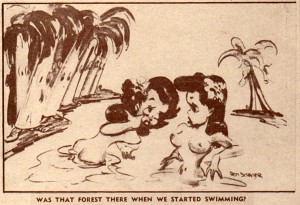
A rare Rod Scribner print magazine cartoon – from the January 1945 edition of “Service Ribbin” a series of special publications for the military published by Motion Picture Screen Cartoonists Union. (click to enlarge)
Scribner’s story for Happy Comics features “Rowdy Runner” – written by Michael Maltese – featuring a road-runner more in the vein of Clampett’s Beaky Buzzard than what Chuck Jones would design in later years. Considering the backlog for this story as well, this story assuredly was drawn while Scribner was animating for Clampett. The fourth page, as the constable possum awakens in a daze after hitting a nearby tree, strikes a notion that Rowdy is the culprit to his harm, and his destroyed motorcycle—bursts with inner emotion, just as the best of Scribner’s animation evokes for Avery and Clampett.
Again, a reel of Scribner’s scenes by Thad Komorowski, all comprised of his work for Warners:
Scribner’s “Rowdy Runner” here (click to enlarge each page):

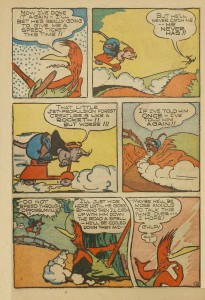

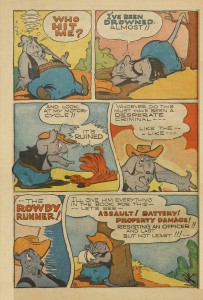


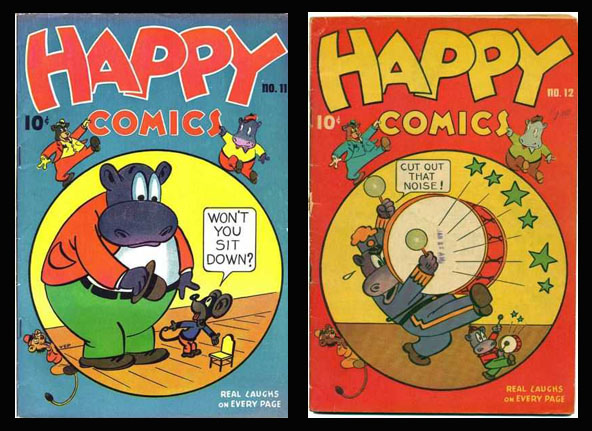
HAPPY COMICS #11 and #12. Cover art by Víctor Estenio Pazmiño (aka VEP)
(Thanks to Thad Komorowski and Michael Barrier for their help.)


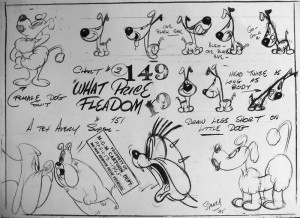
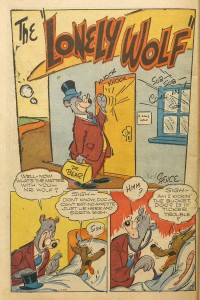
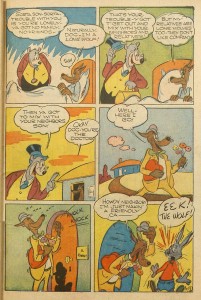

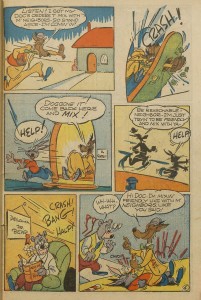
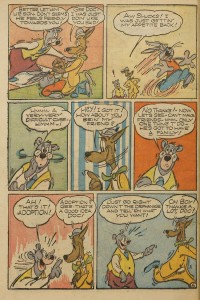
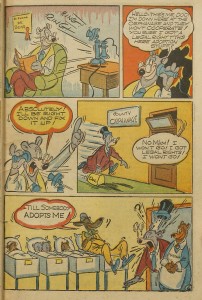
 DEVON BAXTER is a film restoration artist, video editor, and animation researcher/writer currently residing in Pennsylvania. He also hosts a
DEVON BAXTER is a film restoration artist, video editor, and animation researcher/writer currently residing in Pennsylvania. He also hosts a 





















































































Wow-ee! Before this post, I didn’t KNOW either of these legendary animators worked in the comics! Great post, Devon! THIS is part of the reason I always come back to Cartoon Research.
A heavenly post!!! Thank YOU!!!
Wow, Spence and Scribner’s work look just as fresh as their animations (these drawings look just like the work of M.G.M’s Our Gang Comics)….
Unfortunately, the second page of “The Lonely Wolf” won’t click…….
Fixed. The second page of “The Lonely Wolf” now enlarges if you click it.
This is fascinating stuff, even if I cannot appreciate the comics. Just hearing about comics panels produced by these two gentlemen makes me wonder just how they looked from panel to panel. From descriptions here of the style of animation, very frenetic, I can imagine what he brought to Tex Avery, but I wonder what he brought to the CAPTAIN AND THE KIDS series. My guess would be that he did work for cartoons like “A DAY AT THE BEACH” or the “fast exit” scenes in “THE WINNING TICKET”. If Spence animated on the two Milt Gross cartoons, those would be my guestimates of his contributions to the only black and white series that MGM ever produced in animation–although those cartoons were always considered sepiatone, not actual black and white. I wonder if those cartoons actually exist somewhere as sepia anymore.
Another great installment of this series, Devon — I admire your ability to research all this stuff!
Perhaps these were the only forays these two great animators made into comics because, as Preston Blair told me about his own one-shot comic book story for Sangor, the amount of work they put into each page for just $8 simply wasn’t justified!
Both of these stories – like nearly every story shepherded at this time by Jim Davis – were lettered by the indefatigable Tubby Millar.
Thanks for identifying Millar as the letterer, Dave. He must’ve been a regular calligraphy machine!
I’m not sure that the scene at 1:01 from “A Tale of Two Kitties” included as examples of Rod Scribner’s animation is actually his work entirely. The drawing doesn’t look correct for most of the scene. Look at the hands, for instance. I don’t think Scribner would have drawn hands like that. A bit of evidence to that effect are the examples of the comic pages themselves. Perhaps near the end of the scene Cat-stello looks more like Scribner’s work. Examining the draft available on this, it does seem to indicate “Rod”, but notice the arrows back to another name earlier in the draft marked “Rev” (Rev Chaney). Certainly the animation is wild, but it’s a bit undisciplined “wild” compared to what Scribner did. Looking at the cartoon, there’s very little Scribner animation in it, but I do believe that Rod did a very detailed storyboard of this particular film. Is it likely that he was kept busy doing the character layouts and might have even directed the other animators?
Some of the poses of the “Road Runner” from page 5 look as if they could have been layouts for “Strife with Father” (1950, McKimson) of Beaky Buzzard, especially scenes animated by Emery Hawkins.